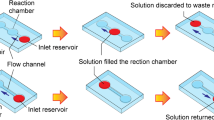Abstract
This manuscript presents an integrated fluorescence detection system including a disposable microfluidic chip integrated with an optical fiber for fluorescence immunoassays. When fluid samples and reagents were transported to the microfluidic chip by a MEMS-based micropump, the fluorescent light, which was induced by the excitation light from an LED coupled into the detection area of the microchannel through an optical fiber, was detected by a PMT. The system was able to detect from 1 to 1,000 μg/L fluorescein with a correlation coefficient of 0.966. In order to demonstrate the capability of the developed system further, human IgG was measured by the dual-antibody sandwich method by using this detection system. Several critical parameters such as different surface modification methods for antibody immobilization and various primary antibody concentrations of the sandwich immunoassays were optimized. Under the optimal condition, the detection range of human IgG was 0.16–20 mg/L with a correlation coefficient of 0.9802. The integrated fluorescence detection system has the potential to be used in the field of on-line point-of-care clinical testing.








Similar content being viewed by others
References
Brown E, McDermott T, Bloch K, McCollom A (1996) Defining the smallest analyte concentration an immunoassay can measure. Clin Chem 42(6):893–903
Cesaro-Tadic S, Dernick G, Juncker D, Buurman G, Kropshofer H, Michel B, Fattinger C, Delamarche E (2004) High-sensitivity miniaturized immunoassays for tumor necrosis factor α using microfluidic systems. Lab Chip 4(6):563–569
Chabinyc M, Chiu D, McDonald J, Stroock A, Christian J, Karger A, Whitesides G (2001) An integrated fluorescence detection system in poly (dimethylsiloxane) for microfluidic applications. Anal Chem. 73:4491–4498
Chen X, Cui D, Liu C, Li H, Chen J (2007) Continuous flow microfluidic device for cell separation, cell lysis and DNA purification. Anal Chim Acta 584(2):237–243
Cho J, Han S, Paek E, Cho I, Paek S (2006) Plastic ELISA-on-a-chip based on sequential cross-flow chromatography. Anal Chem 78(3):793–800
Cui D, Geng Z, Chen X (2006) A hybrid Silicon-PDMS micropump actuated by PZT bimorph. Rare Metal Mater Eng 35(Suppl 3):319–320
Effenhauser C, Bruin G, Paulus A, Ehrat M (1997) Integrated capillary electrophoresis on flexible silicone microdevices: analysis of DNA restriction fragments and detection of single DNA molecules on microchips. Anal Chem 69(17):3451–3457
Hatch A, Kamholz A, Hawkins K, Munson M, Schilling E, Weigl B, Yager P (2001) A rapid diffusion immunoassay in a T-sensor. Nat Biotechnol 19(5):461–465
Higgins J, Nasarabadi S, Karns J, Shelton D, Cooper M, Gbakima A, Koopman R (2003) A handheld real time thermal cycler for bacterial pathogen detection. Biosens Bioelectron 18(9):1115–1123
Johnson M, Landers J (2004) Fundamentals and practice for ultrasensitive laser-induced fluorescence detection in microanalytical systems. Electrophoresis 25(21–22):3513–3527
Li H, Lin J, Su R, Uchiyama K, Hobo T (2004) A compactly integrated laser-induced fluorescence detector for microchip electrophoresis. Electrophoresis 25(12):1907–1915
Liang Z, Chiem N, Ocvirk G, Tang T, Fluri K, Harrison D (1996) Microfabrication of a planar absorbance and fluorescence cell for integrated capillary electrophoresis devices. Anal Chem 68(6):1040–1046
Lin C, Lee G, Fu L, Chen S (2004) Integrated optical-fiber capillary electrophoresis microchips with novel spin-on-glass surface modification. Biosens Bioelectron 20(1):83–90
Liu C, Cui D, Cai H, Chen X, Geng Z (2006) A rigid poly (dimethylsiloxane) sandwich electrophoresis microchip based on thin-casting method. Electrophoresis 27(14):2917–2923
Liu C, Cui D, Chen X (2007) Development of an integrated direct-contacting optical-fiber microchip with light-emitting diode-induced fluorescence detection. J Chromatogr A 1170(1–2):101–106
Manz A, Fettinger J, Verpoorte E, Lüdi H, Widmer H, Harrison D (1991) Micromachining of monocrystalline silicon and glass for chemical analysis systems A look into next century’s technology or just a fashionable craze? Trends Analyt Chem 10(5):144–149
Miyaki K, Guo Y, Shimosaka T, Nakagama T, Nakajima H, Uchiyama K (2005) Fabrication of an integrated PDMS microchip incorporating an LED-induced fluorescence device. Anal Bioanal Chem 382(3):810–816
Novak L, Neuzil P, Pipper J, Zhang Y, Lee S (2007) An integrated fluorescence detection system for lab-on-a-chip applications. Lab Chip 7(1):27–29
Rosamund D, Finkelstein J (2006) Insight: Lab on a chip. Nature 442(7101):367–418
Acknowledgments
This work was supported by the National Natural Science Foundation of China (Grant Nos. 60701019, 60976088 and 60971071).
Author information
Authors and Affiliations
Corresponding author
Rights and permissions
About this article
Cite this article
Chen, X., Cui, D., Li, H. et al. Microfluidics-based immunoassays by using an integrated fluorescence detection system. Microsyst Technol 16, 2049–2055 (2010). https://doi.org/10.1007/s00542-010-1150-5
Received:
Accepted:
Published:
Issue Date:
DOI: https://doi.org/10.1007/s00542-010-1150-5




